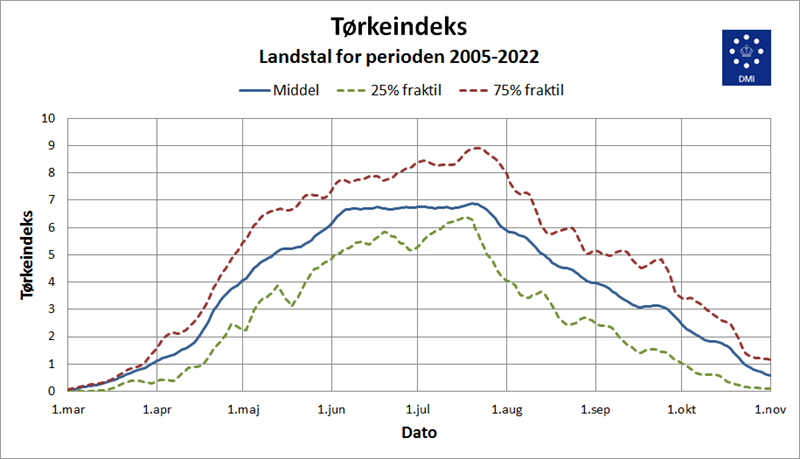Drought and climate change
The global climate system will become warmer, and many of the temperature rises we have registered since the 1950s are the highest ever observed. It is expected that summers will be drier, which means we will experience periods with drought in the future. This will affect the state of ecosystems and agriculture. For example, the drought in the summer of 2018 had negative implications for agriculture, and harvest yields fell.
Over the past 18 years, the Danish Meteorological Institute has continuously calculated the drought index for Denmark - as a whole and by municipality. The drought index is based on a water-balance model, which each day estimates the water volume in the soil water reservoir available to plants.
Figure 1 shows the drought index for all of Denmark as mean value and the 25% and 75% fractiles. The drought index is important in assessing irrigation needs, crop choices and fire hazards. Trends in the number of days with drought can provide important and easy-to-understand information that can be used to prevent problems caused by drought.

Figure 1: Denmarks drought index for the period 2005-2022 as mean value and the 25% and 75% fractiles. Source: DMI.
The precipitation is measured by the Danish Meteorological Institute's network of precipitation stations, while evaporation is calculated on the basis of empirical formulas based on observations from the Danish Meteorological Institute's weather stations. Infiltration is estimated on the basis of precipitation and evaporation. The model covers all of Danish land surface.
Future drought in Denmark
Figure 2 shows the percentage change in the number of dry days in the summer (June-Aug) throughout Denmark for the period 1981-2010 and for the future periods 2011-2040, 2041-2070 and 2071-2100 for a lw, a medium and a high emmission scenario.


Figure 2: Future drought days (on the top) and dry spells (on the bottom)
On the top is the number of dry summer days with less than 1 mm of precipitation, on the bottom the length of the longest continuous dry period in summer. The projected end-of-century change for a high discharge scenario is 7% (with an uncertainty range of −4 to 12%) for the number of dry days, and 11% (with an uncertainty range of −11 to 32%) for the longest dry period .
Read more and explore the data on Klimaatlas.dk.
Senest redigeret:
06-07-2023